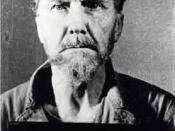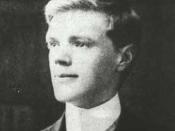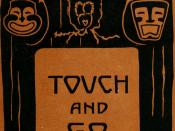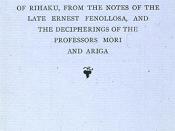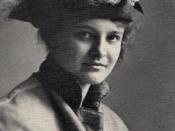In choosing images and characters that were traditional in both eighteenth and nineteenth century British literature, D.H. Lawrence creates a modern method of approaching literary themes. As he twists and turns these traditional figures to refocus them into more modern characters, he provides a snapshot of~more true-to-life figures; ones that a reading public can better identify and relate to. Traditionally, characters were presented as heroic figures with no personality flaws, of immeasurable virtue and revered by all and sundry, yet D.H. Lawrence's characters do not meet this criterion whatsoever.
In the short story, "Daughters of the Vicar," Lawrence presents us with what appears to be a traditional English character - the vicar - a religious figure that is both supported by and yet remains above the community at large. Traditionally a vicar is an educated man, often a second or third son of a noble family, and while he does not inherit the family wealth, the vicar remains on the cusp of nobility, better than the common man, and yet paid by him.
What we are expecting to appear in the story is a man of God - what we receive from D. H. Lawrence is not.
In accordance with Ezra Pound's directive to "Make It New," the vicar that we are presented with in this short story is not a peaceful gentleman of the cloth. Rather, he is a shamed and indignant one who submits to "conscious hatred of the majority of his flock, and unconscious hatred of himself" (137). Clearly, this is not the Christian ideal, and a vicar who is forced to accept a "narrow round of cottages" surely will not be able to support himself and his family in comfort upon a portion of the tithes of his congregants (137). This image of the poor and frustrated Mr. Lindley is reinforced as "he had not the nature nor the wish to make his society agreeable⦠Nor the strength to impose himself where he would have liked to be recognised" (137). Clearly, this vicar is not the figure of much esteem to anyone and especially not to the congregation he serves.
His wife is the next character to whom we are introduced, a woman who marries the young vicar, only to come to hate him, to loathe what she has become within their marriage, mortified that she can only be "met with general, callous ridicule when she tried to be impressive," due to both her husband's lack of funds and his lack of character as a shepherd to his flock (137). This is a woman who sought to marry a man of society, to become a matron and a role model to the community, but ends in the role of a "mechanically" childbearing woman, performing her "maternal duty, which was forced upon her" (137).
The description of Mrs. Lindley is clearly modern, both in the choice of wording and in the presentation of her role as a wife and mother. The use of the word "mechanical" seems something of a shock within the text. As if the imagery was not modern enough, here is a word that truly jolts the reader. When used in the context of her womanly role, it seems even more revolutionary. Her matronly role is "forced upon her" - clearly she does not relish becoming more of a woman via childbearing, but rather does not even want to submit to her husband and his historical role of sexual dominance within their relationship. This resulting angst is proven intolerable to her as she "became an invalid and took to her couch" (138). Clearly this is not a traditional story about a wonderful God appointed vicar in jolly old England bringing religion and hope to his flock and love and attention to his wife.
The reader is again jolted by the description of the children, who "had that curiously clean, semi-transparent look of the genteel, isolated and poor" (138). It was generally accepted prior to this period that the subjects of most works of fiction are not described as vapid lonely individuals, urged on by their parents to societal ambition and hated by the rest of the parish due to the haughtiness of their expression as contrasted to the "long, grey, unfitting trousers" of the sons (138). There is no creation of character in the introduction of the reader to the children, each is simply a part of the whole, trained in the same fashion by parents who want them to believe they have a higher societal standing due them despite the family "haggling to make ends meet" (138).
However, it is two of the children in particular who are at the crux of the story, Mary, the oldest daughter and Louisa, the second oldest. Both raised in agreement with their parents' determination of their stature, they nevertheless are forced to seek income outside the home as well, with Mary becoming a governess and Louisa a piano teacher. This is significant for three reasons: first, while they do not fit the role of the New Woman, they nevertheless are required to help support the family financially; second, the reader is not given to see this as a juxtaposition of the girls' social stature versus the need to work; and third, the girls themselves do not seem to consider this a lowering of their own individual station. What would have been anathema a mere decade or two earlier is now the accepted norm.
Yet the character of each of the girls is truly the main contrast within the short story and depicts the greatest modernity within its confines. While both are presented as dutiful, we are clearly given to see that each girl yearns to escape the life she lives, however each chooses to go about it differently. Mary is the traditionalist, choosing to suffer a marriage in which she had "bought her position in the world" so as to be free from the poverty which she experienced within her own family (153). What makes for a different interpretation however, is the way in which the relationship is described. There is no sacrifice for a greater good, but rather, a trading of evils, "She had paid with her body," but her "private life was her shame" (153). Instead of feeling a sense of respect for the young woman who had sacrificed herself "because of the money that came to the vicarage from Mr.Massy," the reader instead pities Mary (160). She is a woman who has sold herself and "had got rid of her body," then upon bearing a child finds herself almost hating it, "because it made her live again in the flesh" (153, 154).
This focus upon the body is a thing practically unheard of and considered almost obscene at the time of writing, particularly with any inference of sexuality. This is a woman who seeks to escape her body, and the will of her husband, who was "like a cold machine" (154). Mr. Massy is described as emotionless and "devoid of human understanding," another young clergyman who lacks basic relational skills (153). Both Mary and Mr. Massy represent traditional characters that have been manipulated into modern works of art, each a failure in these traditional roles, Mary for not accepting the fate she has chosen and Mr.Massy in being another vicar who seems to be so inadequate for the role.
By contrast, Louisa is presented as "short and plump and plain," a young woman who perhaps fits in better with the coal miners of the community, slightly more ordinary than her tall and statuesque sister (160). As a result of her sister's marriage to Mr. Massy we are presented with the traditional younger daughter determination to marry for love - "I will love the man I marry - that is all I care about" (156). Yet even still, this cannot be allowed to go in the traditional way, where the young woman finds the perfect man to love her and who is good for the family. "Make It New," Ezra Pound demands, and new it therefore must be!Instead of the young lord/vicar/educated next door neighbour, Louisa finds herself pining for the son of a tailor, a boy who questions his own masculinity despite his discharge from Her Majesty's Royal Navy, and of course, a collier. Yet love is Louisa's directive and love she shall have. To marry her young Alfred Durant, Louisa must make sacrifices, the first of which being that her father cannot even read the banns to the parish - her wedding must be announced at the registrar. It is an embarrassment for Mr. Lindley, who says, "I have my position to maintain, and a position which may not be taken lightly" (184). To that end, love forces Louisa to not only be married outside of her family's domain with little celebration or even acknowledgement, but then is requested to leave the vicinity so as not "think of herself" but to "love [her] parents and ⦠want to spare them as much of the - the loss of prestige as possible" (185).
Clearly, there is no winner between the sisters. Each is merely a foil for the other, a traditional character faced with the possibility of an ending unexpected, yet more true-to-life and therefore more vibrant than ever before. Within "Daughters of the Vicar" the reader is presented with the traditional made new, a traditional family, traditional choices and yet, untraditional results. Not one character is truly a hero, nor is one truly a villain but each is presented as merely a series of choices and limitations. The expectations of the reader are continuously thwarted, not just by what is expected of these usual characters but also by the feelings of these characters themselves. There is no contentment and no resolution, yet the story ends with two separate daughters choosing two separate courses in life, two traditional courses with unexpected but infinitely more lifelike results. These old worn characters are truly "new."Works CitedLawrence, D.H. "Daughters of the Vicar." Studies in Twentieth Century BritishLiterature Before 1945 Course Reader. Compiled by Mary Ann Gillies and Aurelea Mahood. Simon Fraser University, 2006. Reading 1.5. 136-186
